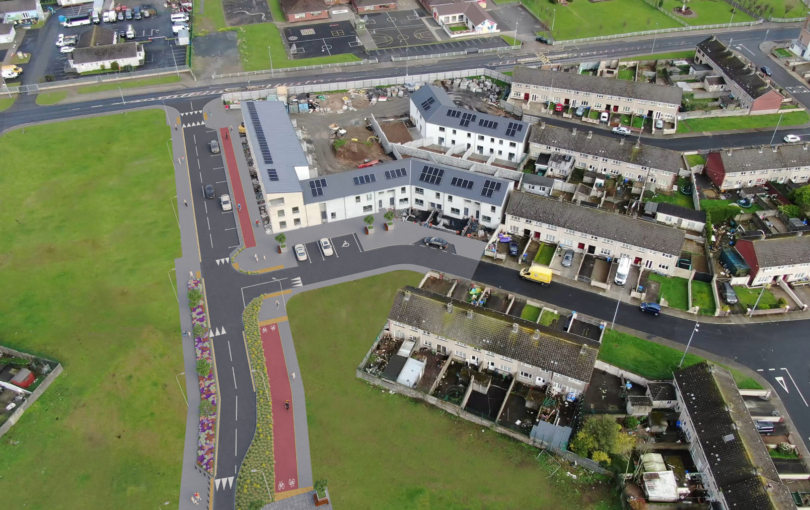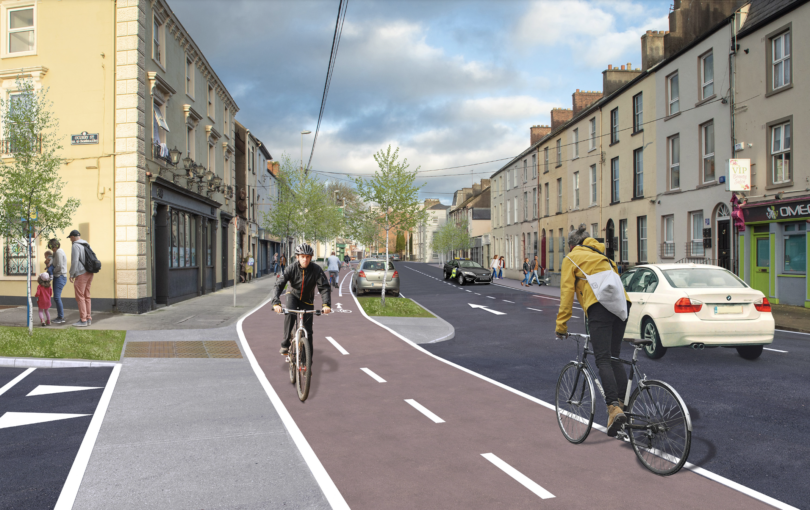Limerick is a small city with many wide straight streets and a flat topology. 75,000 citizens of Limerick live within a 15 minute cycle of the city centre. Here are a number of actions that Limerick Cycling Campaign believe could make Limerick one of the most cycle friendly cities not just in Ireland but anywhere in the world.
1. Make cycling an integral part of Limerick’s transport network
The main goal of the Limerick Cycling Campaign is to make cycling an integral part of Limerick’s transport network. By reducing our dependency on private motor traffic, we can develop a transport network that is efficient, scalable and sustainable – all things that a car dominated transport network can never be. We are not against cars. We believe cars have their part to play in our transport networks too but not to the debilitating level that they do today. We don’t believe everyone should cycle either because for many, it just wouldn’t be practical. But 50% of journeys under 2km in Ireland are made by car. That goes up to 66% for journeys from 2-4km. The vast majority of transport capital expenditure is spent on roads to accommodate the insatiable needs of private motor traffic. We need to change this model and invest in all sustainable modes of transport such as walking, cycling and public transport.
2. Develop a connected, coherent & safe utility cycling network
To make utility cycling an integral part of Limerick’s transport network, we need a connected, coherent and safe cycling network to travel on. Limerick currently has a low number number of poor quality disconnected cycle lanes dotted around different parts of the outer city. By continuing to develop cycle lanes in a piecemeal fashion we are not encouraging the growth of cycling as an integral part of the transport offering in Limerick. In order to encourage people to use bikes as an attractive and feasible alternative, we need to embrace the need for a cycle lane network in Limerick that meets the following criteria:
- Segregated – Fundamental to getting people out on bikes is making it as safe as possible for them to do so. One of the core elements in achieving this it to create cycle lanes that are physically separated from motor traffic. Mixing cycle and fast moving motor traffic on busy urban carriageways is never safe so in order to increase safety and make cycling more attractive we need separation of cycling traffic from motor traffic. This greatly enhances the safety of the cycling environment and is crucial to increasing bike use in Limerick. Segregated cycleways may require space from carriageways to be reassigned to cycleways but we must face the reality of what is required to make cycling safe and a more attractive transport option
- Coherent A cycling network by its very nature has to consist of properly connected cycling lanes that will get bike users to the places they want to go to efficiently and effectively. LCC believe that a person on a bike should be able to get from suburb to city street and back out on a cycle lane with minimal, if any, interaction with motor traffic. Limerick’s population is forecasted to grow by 50% over the next 20 years – we cannot fit any more cars into the existing space between buildings, so we have to introduce more efficient and more scalable modes of transport sooner rather than later
- Permeable The cycle lane network should allow people on bikes to get right into the heart of the city from their front door. As a means of transport the bike is a far more efficient use of space than the car and the network should be designed in such a way that favours direct and user-friendly bike access to the city centre and all major suburban areas
A cycle lane network that meets the characteristics as discussed above should be a major cornerstone of the overall transport strategy for Limerick. It would not only encourage more people to get around town by bike but it would have a positive impact on transport in general as more people using bikes as their primary mode of transport means less cars on the road and hence less traffic congestion.
3. A Dedicated Cycle Transport Officer
A dedicated cycle transport officer employed within the council is a vital element to the development of a successful cycle network. We believe that road and street projects in Limerick have suffered from a lack of such a role. Generally, in terms of road/street projects cycle infrastructure is not seen as an integral part of design and is more an afterthought or something that is added on if space and budget allows. Employing a dedicated cycling officer with knowledge of cycle network and infrastructure design would mean that all road and street design projects would be assessed from cycle traffic’s viewpoint and how it contributes to the overall transport network.
In addition to understanding and overseeing infrastructure design, the cycle transport officer should be responsible for raising the awareness and understanding of cycling as an integral part of a transport strategy, something that we believe has been lacking in practically all transport plans and strategies to date. We would see the cycling officer as a key decision maker that would have a positive impact on how cycling is perceived not only at a strategic level within the council but also on a day-to-day basis thereby instilling a knowledgeable cycling culture within the local authority.
4. Produce A Cycle Network Implementation Plan
In order to realise the goal of a fit for purpose cycling network it is vital that an implementation plan is in place. The lack of a cycling network implementation plan has severely hampered the creation of a safe and coherent cycle network in Limerick. The upcoming transport strategy for Limerick city offers the perfect opportunity to create such an implementation plan. This should set out specific goals, methods, responsibilities and deadlines with regards to delivering a safe, coherent and connected cycle network for Limerick. Having such a plan in place creates a firm foundation on which to design and construct such a cycle network. Sustainability will be key to transport in Limerick going forward and having a safe and coherent cycling network in place should be a vital part of this. Without a cycle network implementation plan in place this will be very difficult to achieve.
5. Provide Easy and Affordable Access to Bike Sharing Across the City
Limerick’s bike share service is the worst performing bike share service in Ireland. There are a number of contributory factors for this, but the main ones are that the bike stations are not located where people live or where they want to go and are regularly out of order. Unless this service is expanded out to areas such as Caherdavin, Castletroy, Dooradoyle, etc, and the quality of service improves, we cannot see it ever succeeding. If the company behind Limerick’s bike share scheme is unwilling to improve this service, then alternative bike share providers should be sought and encouraged to come to Limerick. Bike sharing has been hugely successful in the growth and normalisation of everyday cycling in Dublin and Limerick should not be any different.
6. Enable Utility Cycling Before Promoting It
Research around the world shows that enabling rather than just promoting cycling is key to increasing cycling’s transport modal share. While events such as Bike Week have to be welcomed they will have limited impact in terms of increasing cycling numbers if we do not properly enable people to cycle. Enabling people to cycle is achieved, in the main, by the creation of a safe and coherent cycle network. If people do not perceive cycling to be safe, then all the promotional efforts in the world will have little impact on convincing people to choose a cycle over a car to get from A to B. The statistics prove that. Once we have the basis of a network in place and the number of people cycling increases, then we can consider events that promote utility cycling.
7. Ensure Domestic and Commercial Urban Planning Applications Cater for Easy & Secure Cycle Access and Storage
When discussing cycle networks, it’s easy to solely focus on the infrastructure that makes up the route and lose sight of what’s needed at both the origin and destination. In the Netherlands where cycle traffic is an integral part of the transport system, it has been a legal planning requirement since the 1950’s for all domestic dwellings to provide easily accessible secure sheltered cycle storage. This storage facility must also have easy access to the street outside, otherwise the temptation to use the car, which is usually parked outside the front door, will be too much to resist for many. At destinations in public areas, sufficient secure cycle storage must also be provided in locations that give priority to cycles over cars. Providing cycle storage facilities in a convenient and prominent location near to entrances or places with people will also help reduce bike theft.
To enable people to cycle more, they need to have access to their cycle at all times therefore we would like to see it become mandatory in this country too for all domestic and commercial urban planning applications to cater for easy & secure cycle access and storage.
8. Facilitate multi-mode transport
Limerick Cycling Campaign believe it is vital that the bicycle, as a form of transport, should not be viewed in isolation. Anyone living more than 20km from Limerick city centre will believe that cycling as a mode of transport could never apply to them but that is not true. We should also be developing facilities and infrastructure that help to link cycling in with public transport enabling multi-modal journeys to be a central spine of the Limerick transport system. In the Netherlands, 50% of all train journeys begin or end by bike. That means that people will use more than one mode of transport if necessary to complete a journey. Typically, people will cycle the short trip from their home to the local train station and park their bike there for the day in a safe, secure (usually supervised) cycle storage facility. They will then travel by train to whatever city they work in where if their place of work is beyond walking distance, they will either hire a bike or use another bike of theirs which they store in the destination city’s train station. This concept of the bike as an enabler for longer journeys or commutes has the potential to have a very positive impact on not only cycling as a local mode of transport but also public transport in a wider context. Limerick Cycling Campaign want to integrate cycle transport with both public and private car transport. If we provided secure storage options at bus stops in the suburbs, the bus network would become accessible to a much larger population than it does today. Likewise, if we provided safe overnight cycle storage on the outskirts of the city, many of those currently driving into the city to work every day could cycle the last 2-3km in less than 15 minutes. Investing in multi-modal initiatives will not only benefit cycling but also the wider public transport offering. In turn, an increase in multi-modal journeys will result in lower car dependency and less traffic congestion.


